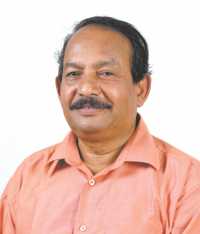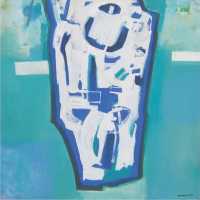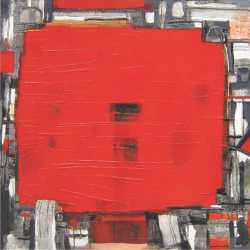| Home - Back Issues - The Team - Contact Us |
 |
| Volume 10 |Issue 48 | December 23, 2011 | |
|
|
Profile Preoccupied with Nature Fayza Haq
As an artist, Mahmudul Haque, always moves on, wishing to bring in new dimensions and expressions in his work. He has endeavoured to experiment in fresh ways, although his subject has repeatedly been nature. "By nature I don't only mean rivers, trees, skies and fields but also man,"Mahmudul says. These are brought in an abstract way. "Paintings are not only the imitations of nature, the essence and beauty of objects are also moulded in the work. When I present the foliage, barks and leaves of grass I have to do this through my brush and colours. If I depict a flower, I want to include its sweet fragrance too and not just bring in the joy of its colour.” "I did various presentation of nature in different phases such as 'Foliage and life', 'Rain' and this time I've brought in the ‘The dance of life on the horizon.’ In the limited space of the canvas, I've tried to portray the vast expanse of nature around me – along with its rhythm, beauty and irresistible charm. The squares at the sides of the paintings are windows and doors to look out at the beauty around us : the trees, leaves, flowers, birds and other elements of fauna and flora. Even when I study the rivers, I get a horizontal line, which I've worked on profusely on this occasion." Mahmudul says he has learnt from all his teachers; they include: Hashem Khan and Kazi Abdul Baset, while Kibria was his "spiritual guru", as he puts it. "I admired Kibria's essence of beauty with his mastery over lines, colours and forms. When I was a student, he taught me even during the holidays. I was totally mesmerised by his works such as 'Donkey and the moonlight'. I was fascinated by his development from naturalistic painter to an abstract one. An artist always aims at combining his individualism with his work. I learnt the grammar of painting from various teachers but the essence of beauty, I got it from Kibria," says Mahmudul." I admire him, but just as I'm influenced by Van Gogh, Matisse, Picasso, Miro, and Rothko, I don't copy them, and similarly I don't imitate Kibria, but rather I try to adapt the finer essence of Kibria's work."
Like his mentor Kibria, he too went to Japan for further studies for five years. His stay in Japan naturally left its impact on him in his work. He has travelled to Europe and the US, visiting the art galleries and learning from them. Talking about how different is Bangladesh from Japan, Mahmudul says that the art students there learn to value art from their childhood, and fine arts mould their outlook and life from the outset. "Art in Bangladesh is still not understood and valued as it should. When I was going to study art, my family had objected, not quite realising the importance of art," says Mahmudul. Mahmudul Haq says that to reach out for progress and dynamism, the Bangladeshi artists had seldom lost track of their roots and had been only looking out to the west for inspiration. Once Head of the Department of Fine Arts, DU, and having held a series of mind-whirling exhibitions at home and abroad since 1976, he said that we didn't have to bring in obvious and apparent images – such as boats, water-lilies, “ek-taras” and beautiful female forms in sari, to depict Bangladesh. Since the late 70s Mahmudul Haque says, he draws his inspiration from nature around him and that there is nothing like semi-abstract in his work. There are simplifications of images from nature around – like the skies, water, trees, flowers, and other local flora and fauna. Undoubtedly, he thinks, there was the impact of the artists who have taught him, guided him, and with whom he has exchanged views overseas, such as in Pakistan, Japan, Europe, most recently in Germany. His exhibits overseas (these overseas displays beginning in his student days in the Far East) also brought him in close quarters with foreign artists and their views. Consequently, he has always been outward looking, without losing sight of his own origin, of which he is fiercely proud. Touching on his belief that we in the east are in no way lagging the west in fine arts, he says, that his teachers like M Kibria, Aminul Islam, Kazi Abdul Baset and Safiuddin naturally influenced artists like himself. As these professors had been to Europe, Japan and USA, they took their inspirations from world over, it followed that their students too kept international values and concepts in mind, while speeding ahead to portray their own life around them. “My teachers went overseas to develop Bangladeshi fine arts,” he says. He learnt printmaking in Japan, with the hope of coming back to Bangladesh, having culled more knowledge in fine arts. He selected the best from what he could envisage from his studies and his experiences.
Dwelling on why he chose the stream of semi-abstract in his vibrant oil compositions, he explains that the departure from realism was a natural consequence of his development of style. He says: colour photography replaced realism and my Impressionistic and Cubist style of simplifying forms. The value of realism has diminished worldwide since the 20th century. Since Francisco Goya and El Greco, the professional artist has combined his emotions and thoughts in his paintings. He thinks, ancient art – considering the Subcontinent, China, Japan, Egypt and Babylon – has always linked up individual perceptions of the artists. The reality in the artist's work should reflect the artist's imagination, experience, and dreams. Mahmudul Haque prefers to depict scenes from his nostalgic past rather than Nature. In the process he sees colours through his own unique vision. The lines are moved to the backdrop, making way for a play of colours. His variation of colours move from red, yellow, blue to black. Once he has selected his colours, he sticks to them. He has always had a complete mastery over his colours. The effect is scintillating and vibrating hues, one playing off another. There is balance and rhythm in the selection and placing of his kaleidoscopic rectangular pieces of colours. The textures change from one form to another. For instance, for him, at one time, vermilion stood for hell and disaster. Green, for the artist, symbolises himself, as existing in the state of happiness in heaven. Although his colours are fluid, the placing of the rectangles make his paintings appear somewhat stylised. At times, when he made his prints, he would cover the full space with black, and then carve out his image, as if with chisel and hammer. His aim was to get as much tonal effect as possible. A cross sometimes appeared in his work, suddenly, out of nowhere. This, he said, was a negative symbol, but this did not mean that he knowingly indulged in pessimism. One gets the feeling of hewn stones in his collages of “kantha” and banana leaves. Although highly open-minded, he is sometimes, conservative in his development of style. Meanwhile, his horizontal images and lines balance with the vertical ones. In this way, he makes the art gaze into his romantic past. He has won many awards, including the Shilpakala Award, 10th National Art Exhibition in 1992, and Honourable Mention Award, 8th Asian Art Biennale, 1997.
Copyright
(R) thedailystar.net 2011 |
||||||||||||


